We’ve been on a roll discussing painting interior wood trim and now we have a home with copious amounts of wood.
And this lovely reader, Connie needs your help to decide whether or not she should paint wood paneling in a historic-style home.
It’s an interesting story, but I’ll let Connie tell you all about it.
I’m actually away and in my fantasies, I was going to save myself some time and just post her photos and let you guys have a go at it.
Ha! That’s akin to – “I think I’ll just stop coloring my hair.”
And believe me, I’d love to do even more because this is my favorite period of architecture–Federal/Georgian, or there about. But instead after I post Connie’s images, I’ll post a few images from the period that her home is styled after.
Dear Laurel,
We recently purchased this home in November. It is in the “Old Town” section of Alexandria, Virginia.
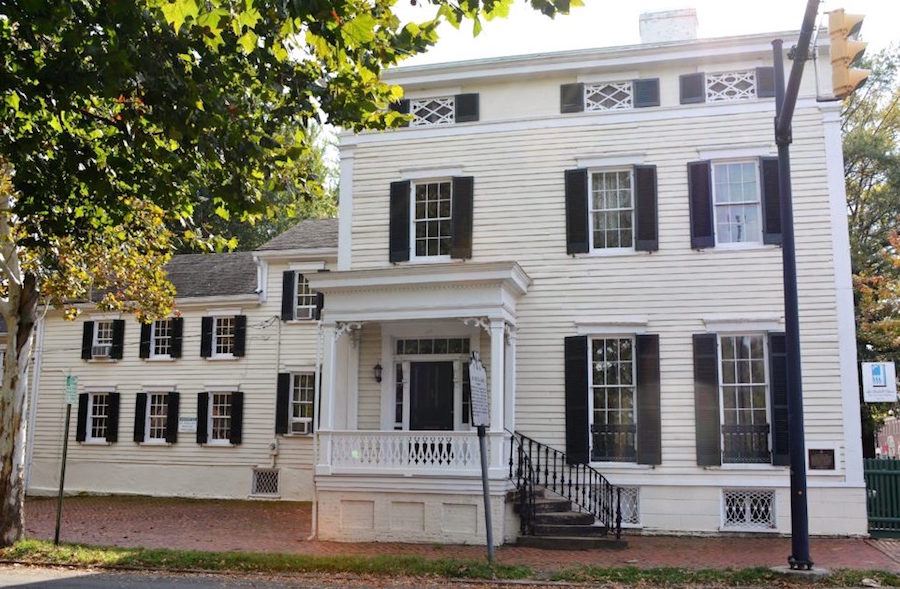
Lee Fendall House in Alexandria, VA
We are surrounded by historic homes, some dating back over 200 years. However, our row-house is relatively new (1976) and it was built on what used to be the stables/mews of the Lee-Fendall House (one of the historic homes in Old Town). So although this house is relatively new, it was built to blend with the surrounding historic homes and row houses.
We bought this house for both the location and for its potential but pretty much everything needs to be updated. Nothing has been done to this home since 1976 and I mean nothing! We are talking mirrored soffits in the galley kitchen, and bathrooms with shell shaped sinks!
The wood paneling and detailing in the living room was a major draw for us.
Even in this area with historic homes, it’s hard to find that kind of workmanship. However it is a bit heavy and the wood has many knots. It seems as though it was lime washed at some point to tone down the orange tone of the wood. Fortunately the room gets plenty of light from the two French doors and a large window.
I will be furnishing this room from scratch but before I buy a single piece of furniture, I need to decide what to do with the walls.
- Either I commit to keeping the walls as is and find furnishings to go with it
- or do I paint the wood paneling?
- If I keep the walls as is, I’m not sure what colors to bring in.
- If I paint the walls, I’m not sure what color to commit to.
- I tend to like lighter colors but I’m not sure if white is the way to go.
I’m at a complete and total loss. “Paralyzed by Perfection” is what my husband calls my current state. I’m in desperate need for your help as well as your readers!
Ooh! One more important fact! This living room is the heart of our home. It is well-used by my husband and I, and our two teenage daughters so it needs to be practical and not overly formal.
A million thanks again for including it in your blog! I’m sure you hear this a lot but really, I am a huge fan! I often spend my free time and weekends reading your current and older blog posts. I get lost in them! Between your amazing sense of humor and the gorgeous pictures, I can spend hours…
Warm regards,
Constance (Connie)
Thank you so much Connie for your kind words. That is one seriously gorgeous home you found. There’s a ton of potential!
But, honestly, I don’t know what I was thinking. If I were home, I would’ve spent 20 hours on this post because I love this period so much.
The style of this home is from the Federal Period which spanned from about 1780-1830. The Lee Fendall Home was built in 1785 and aside from those decorative doo-dads on the portico is a fine example of that period. Undoubtedly, the Victorian ornamentation was a later addition.
Ya know… Keeping up with the current trends of the day.
But, let’s take a look at Connie’s beautiful Federal-style home, built in 1976.
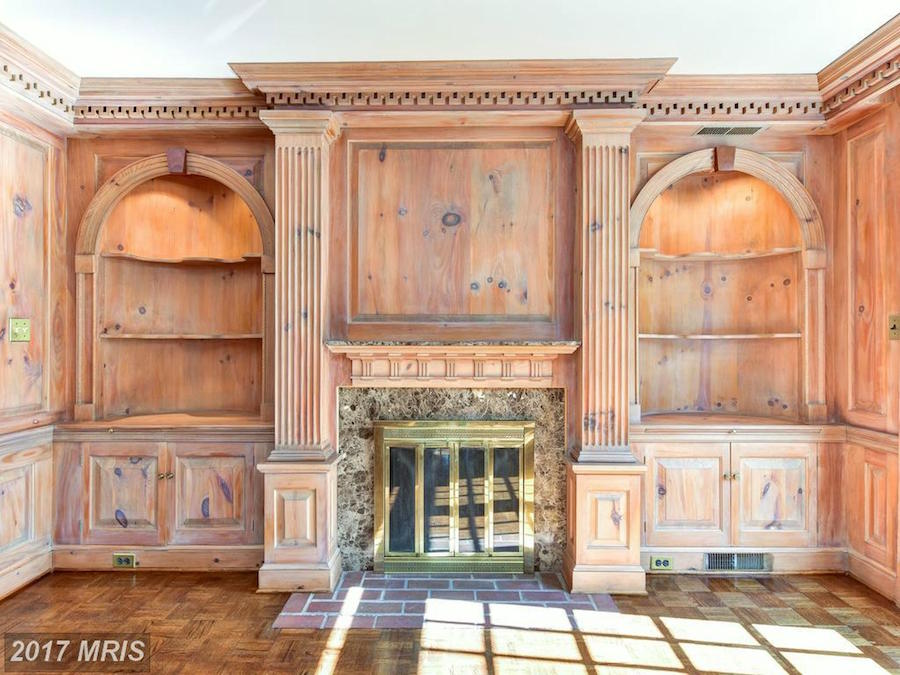 This is the living room.
This is the living room.
 and so is this.
and so is this.
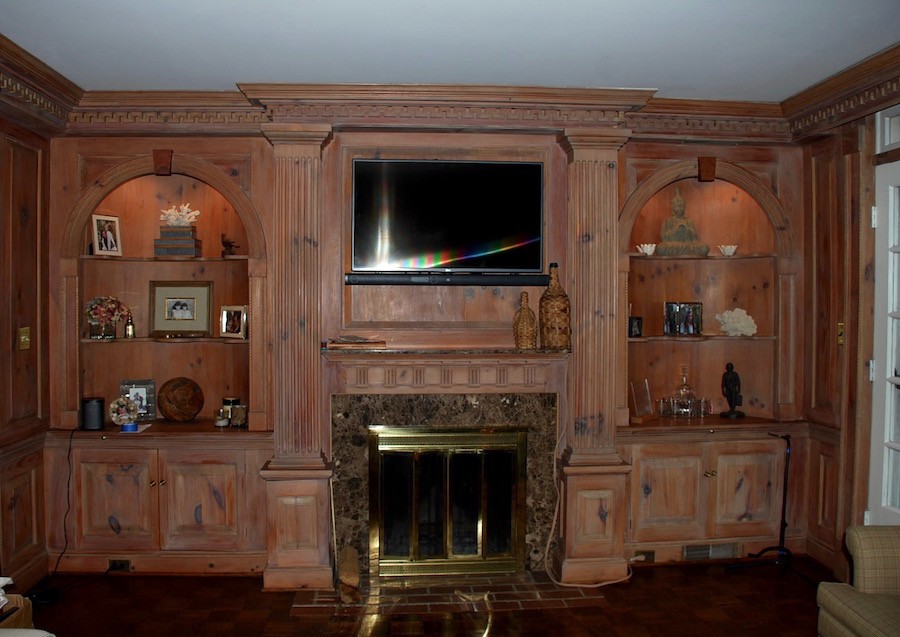 This is the same view as photo number one but a different time of day.
This is the same view as photo number one but a different time of day.
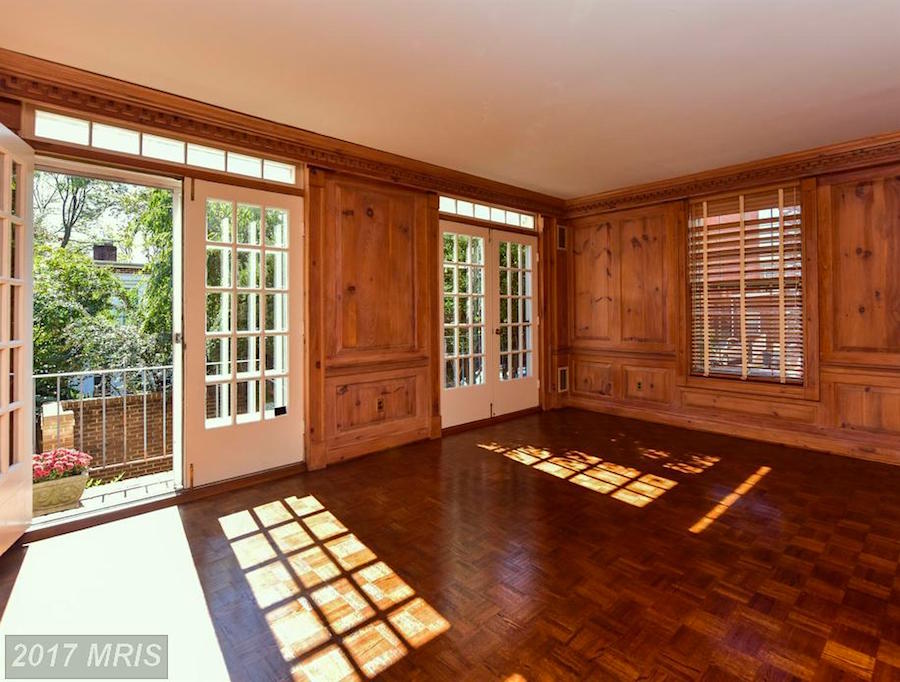 The living room on an obviously bright, sunny day.
The living room on an obviously bright, sunny day.
 The dining room with stained wood trim and Chinoiserie wallpaper
The dining room with stained wood trim and Chinoiserie wallpaper
I do see that the hall is white, wood trim and all.
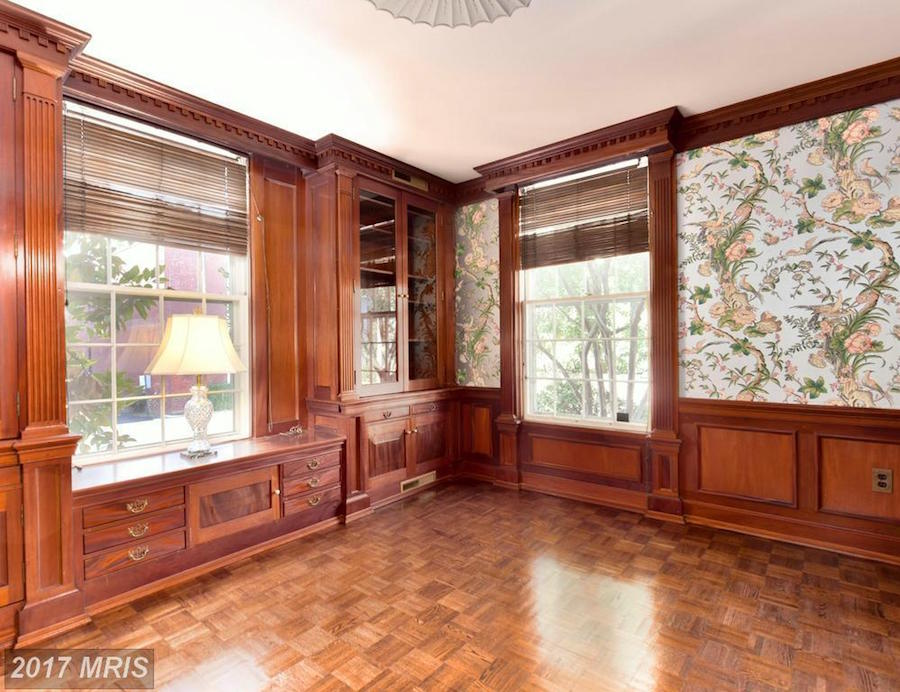 Another view of the dining room with the Chinoiserie wallpaper
Another view of the dining room with the Chinoiserie wallpaper
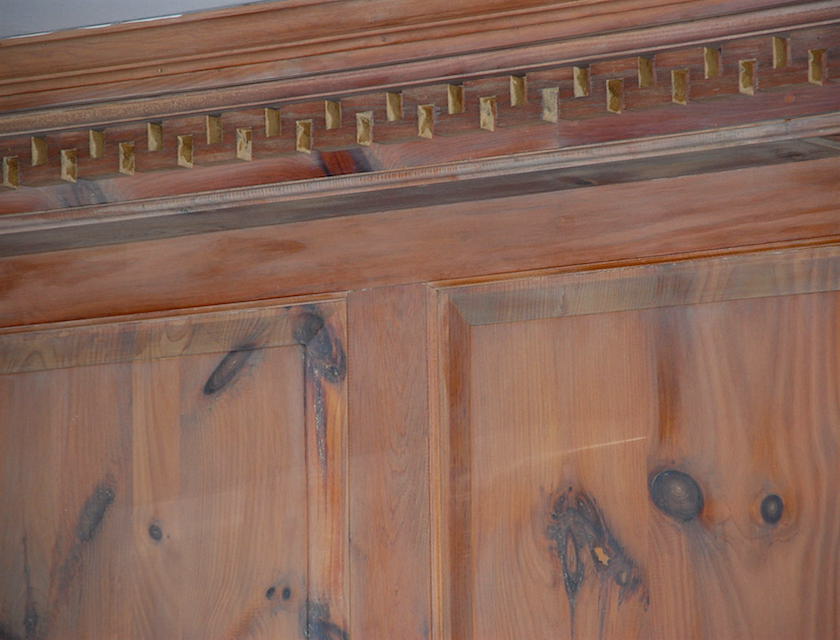
A close-up of the knotty pine wood paneling, that indeed, has been lime-washed. It’s difficult to tell from the images, just what color it is. And I color-corrected the darker images, because they were even redder than they look here. But I imagine the color is somewhere in between the more exposed images in the bright sunlight.
Funny. We just had just been discussing a pine stain that is too red.
In all fairness, the rooms are empty, but that’s a lot of brown. And if stay, will dictate the colors, a lot.
There’s a photo in this post by Mark D Sikes that reminds me a lot of this room. I think that a predominantly blue and white scheme would be stunning with all of the wood.
But lets look at some rooms from the Federal era to see if it is more authentic to paint or to stain the wood.
I also included a few that are either English or American Georgian which started earlier, but is covered in this time period. There’s a lot of overlap in any case.
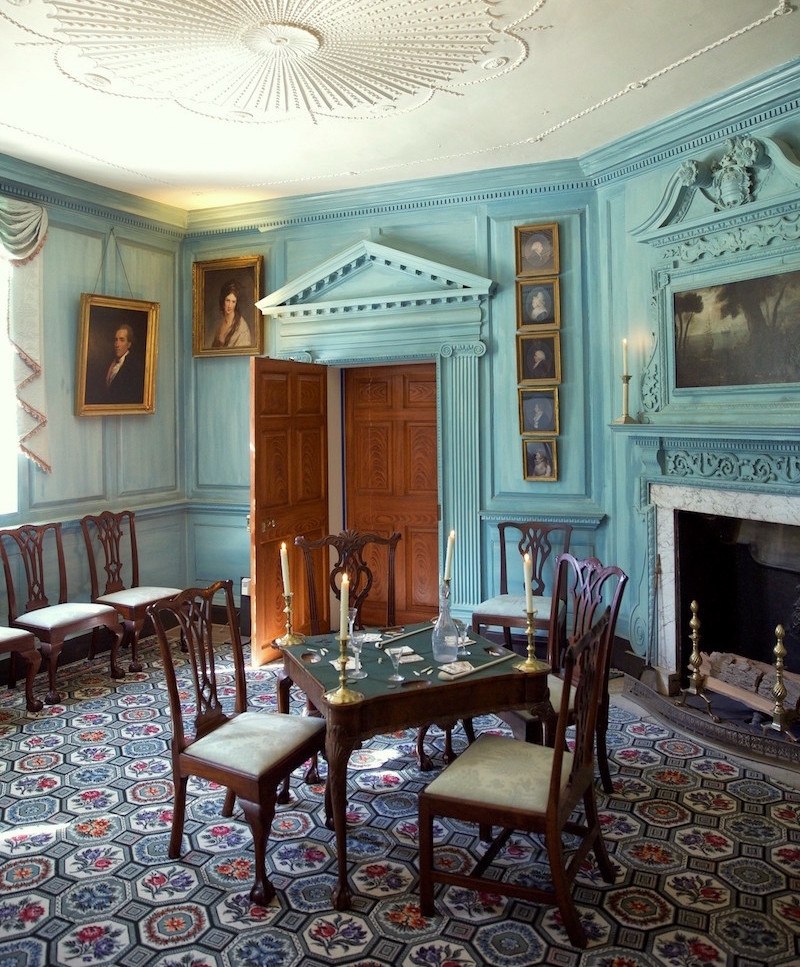 This is a parlor at George Washington’s Mount Vernon home which was built a little earlier and is therefore in the Colonial Period, but it is close-by. I love how all of the painted wood paneling is only one color.
This is a parlor at George Washington’s Mount Vernon home which was built a little earlier and is therefore in the Colonial Period, but it is close-by. I love how all of the painted wood paneling is only one color.
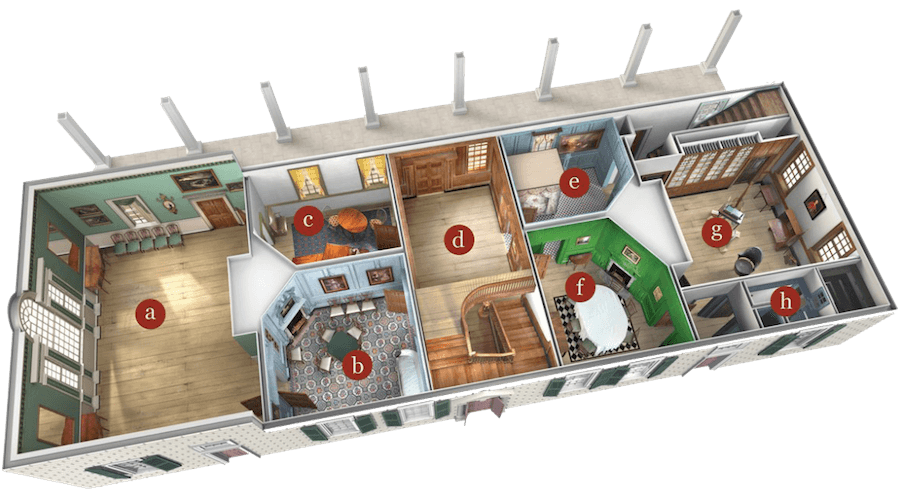 An isometric plan view of Mount Vernon. Here we can see a mix of wood stain paneling and painted wood paneling.
An isometric plan view of Mount Vernon. Here we can see a mix of wood stain paneling and painted wood paneling.
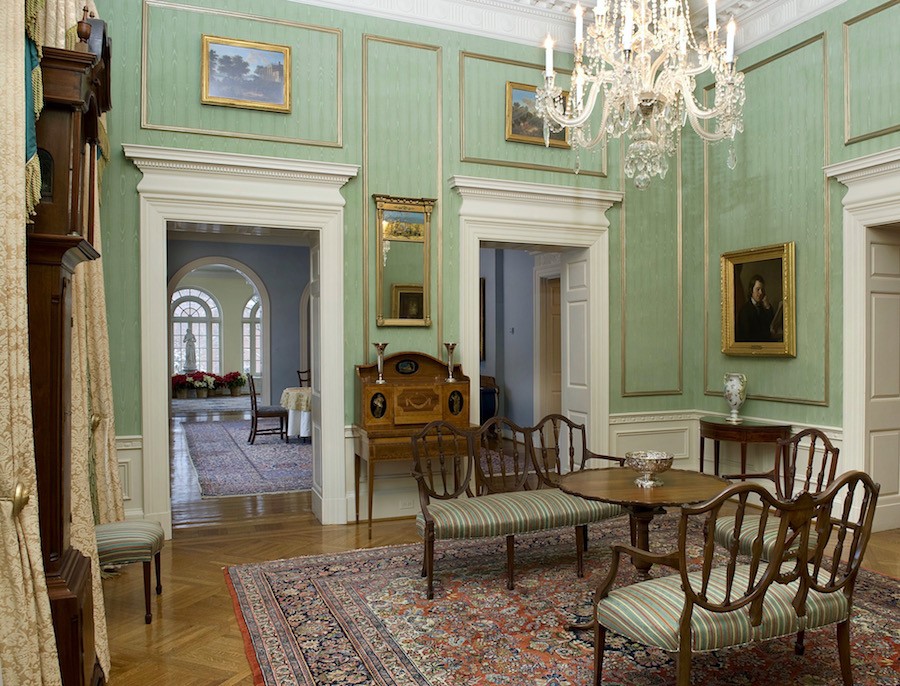 A Federal Government house in Maryland. Yes, too formal, but there is no wood trim in sight.
A Federal Government house in Maryland. Yes, too formal, but there is no wood trim in sight.
This is lovely dining room in upstate New York. Although some might frown at the wood blinds, at least they didn’t use those overly formal, stiff swags and jabots; just not my thing.
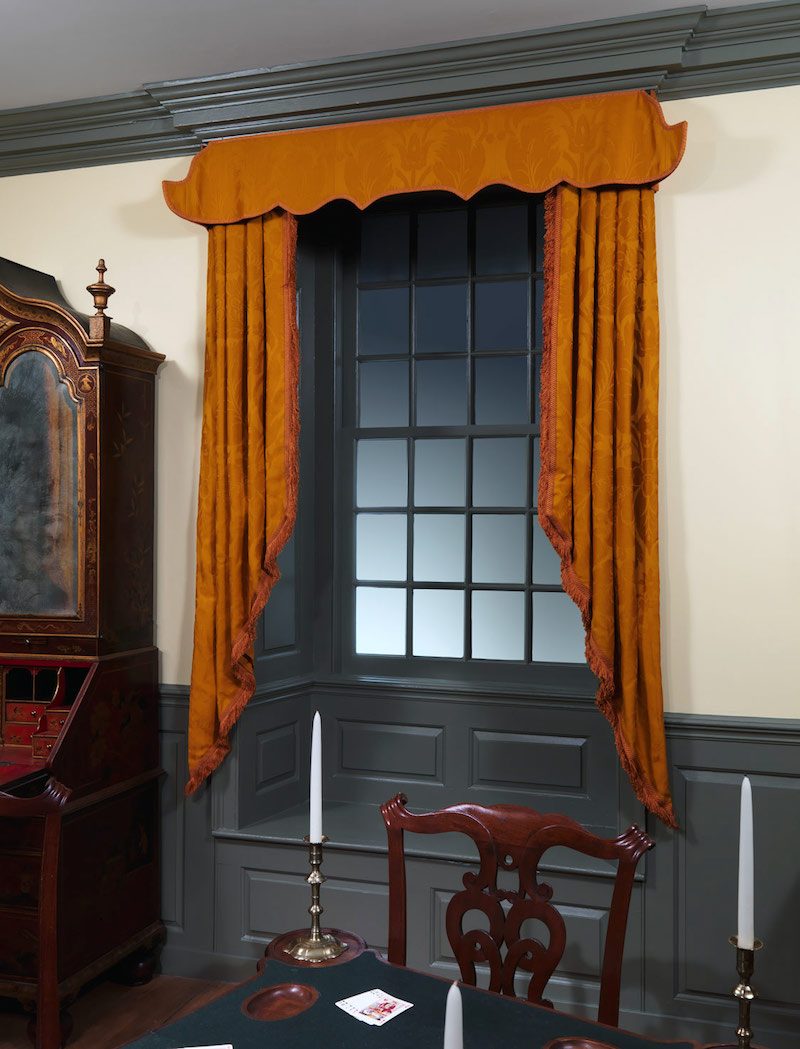 Doesn’t this valance remind you of Miles Redd? His valance would be deeper, but the same shape for sure.
Doesn’t this valance remind you of Miles Redd? His valance would be deeper, but the same shape for sure.
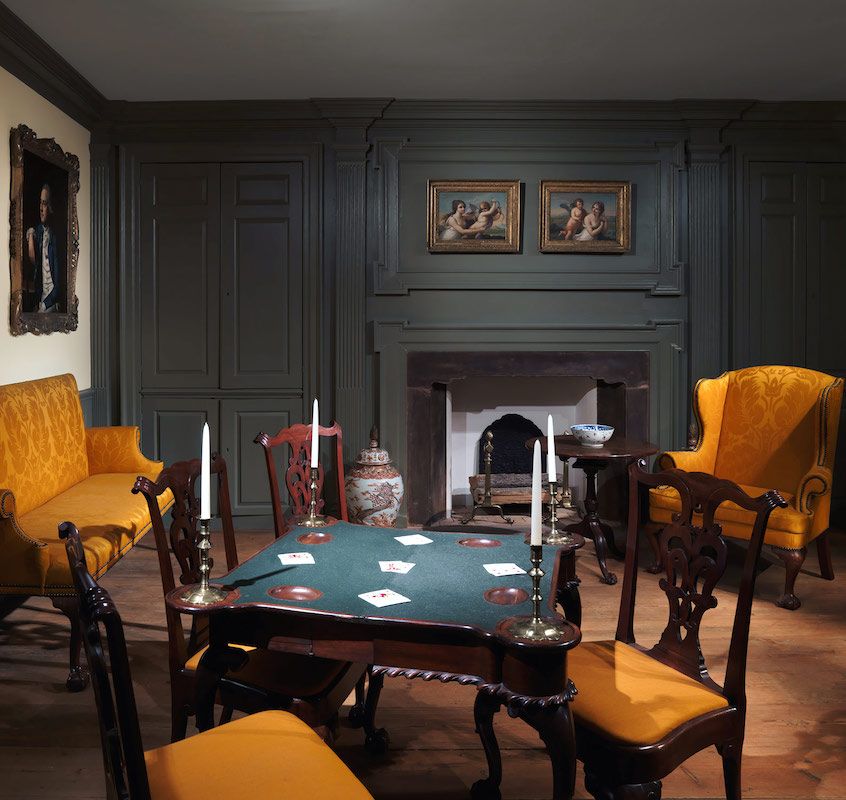 This is another view of the same room which is a room at the Metropolitan Museum of Art – Originally, the Colden House built in Coldenham, New York
This is another view of the same room which is a room at the Metropolitan Museum of Art – Originally, the Colden House built in Coldenham, New York
This house is also mid-18th century and is a fine example of the colonial period of architecture.
Again, it is all painted ONE COLOR. This is historically correct. And it’s not that they never painted the trim white and the walls a color. They did that too.
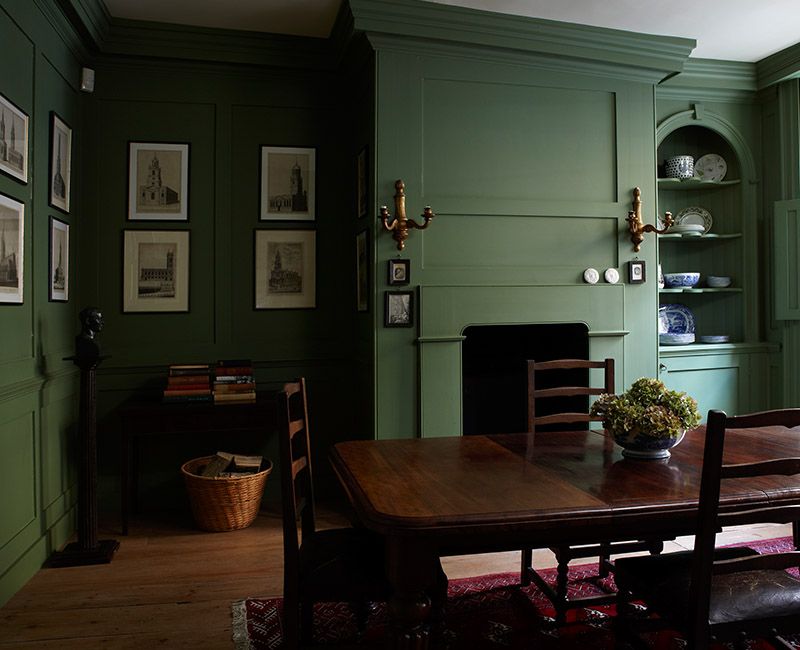 A Georgian dining room painted in Farrow and Ball Calke Green
A Georgian dining room painted in Farrow and Ball Calke Green
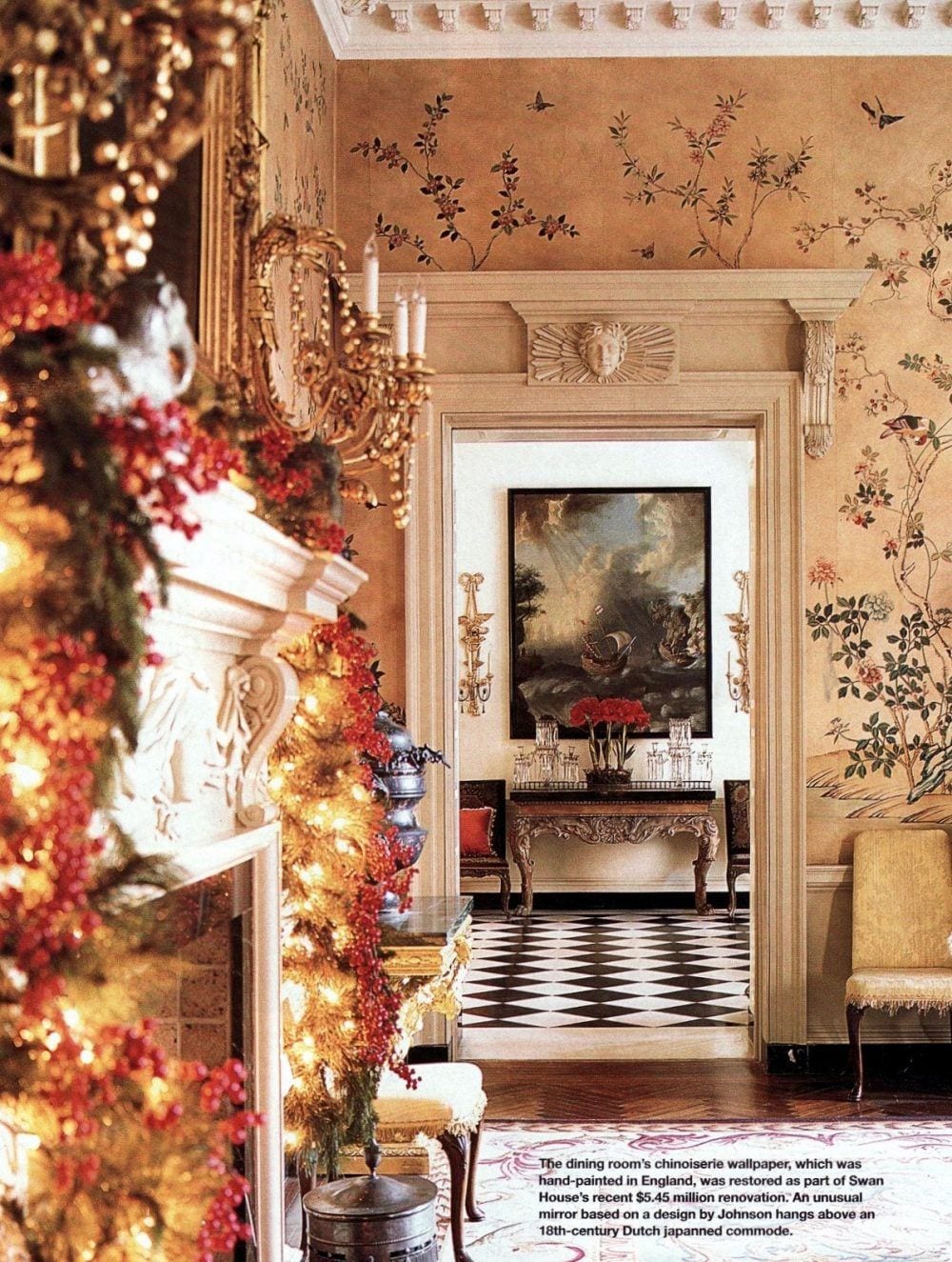
Dan Carithers and Norman Askins – Swan House
This home was built in 1920, but in the manner of the French neo-classical style. I am including it because if the wood trim stayed in the dining room, I would rather see a more complimentary color for the wallpaper.
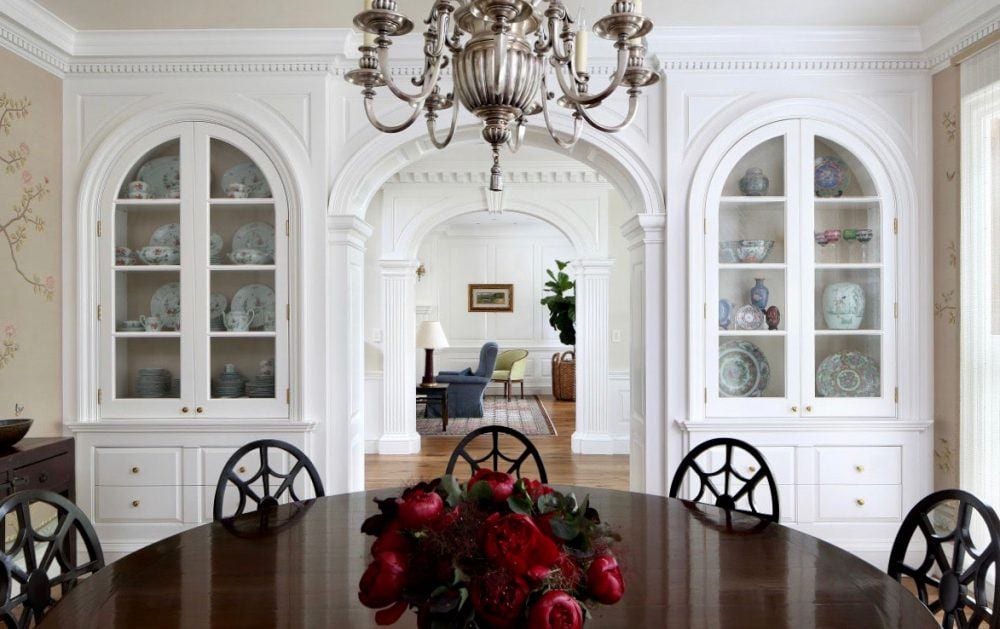
A 1904 home in Atherton, CA – built in the Georgian/Federal neo-classical style. beautifully renovated by Architect David-Buergler, Designer Dara Rosenfeld and builder-Paul Conrado.
I’ll see y’all on Wednesday when I’ll be releasing the new blogging guide!
I apologize because there were some server issues on Tuesday night, and some people had trouble getting onto the site. But my amazing techie, Tim Gary of Mindcue fixed in no time flat.
The cure is a new caching plugin that also fixed the mobile site! Some of you mobile users may have noticed some wonky things going on, but it’s all fixed now.
xo,

Related Posts
 The Only Six White Paint Trim Colors You’ll Need
The Only Six White Paint Trim Colors You’ll Need Here It Is– The Ugliest Stone Fireplace You’ve Ever Seen!
Here It Is– The Ugliest Stone Fireplace You’ve Ever Seen! All About Wainscoting + The One Thing You Must Never Do!
All About Wainscoting + The One Thing You Must Never Do! Pulling My Hair Out! I Need Five Area Rugs That Coordinate!
Pulling My Hair Out! I Need Five Area Rugs That Coordinate! I’m Struggling To Furnish My Large Living Room
I’m Struggling To Furnish My Large Living Room Amazing Classical Architecture and Gardens In England
Amazing Classical Architecture and Gardens In England Is The Gray Paint Fad Finally Over?
Is The Gray Paint Fad Finally Over?


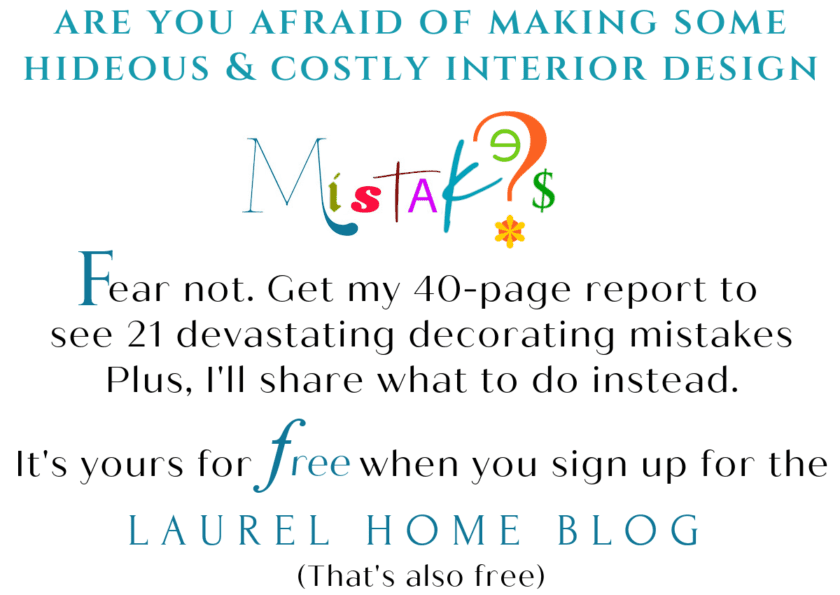


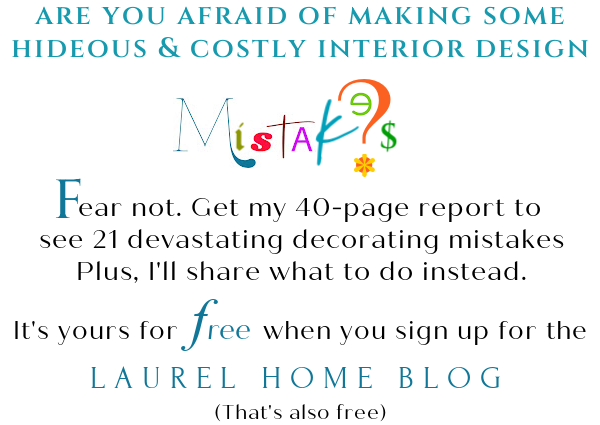
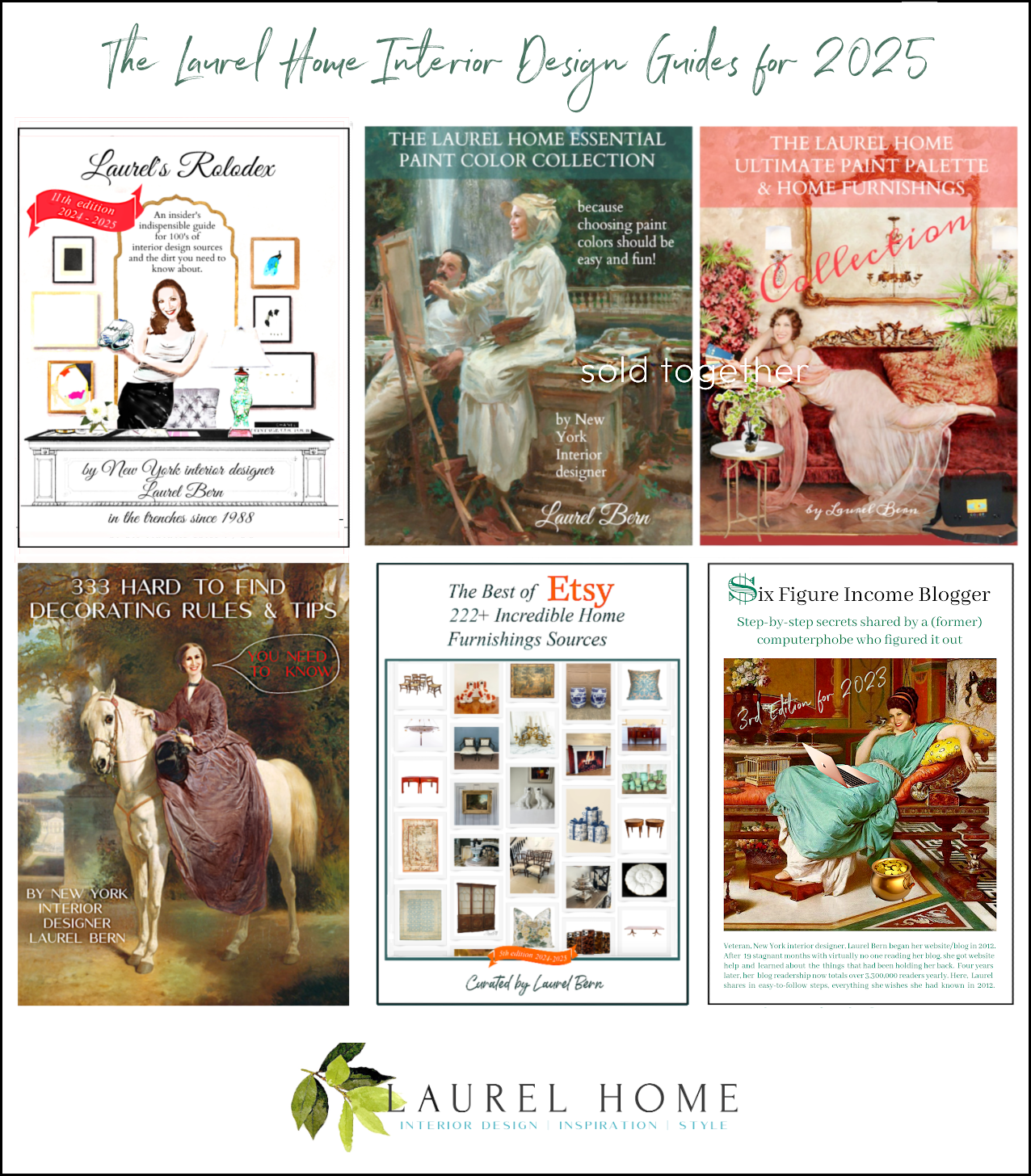

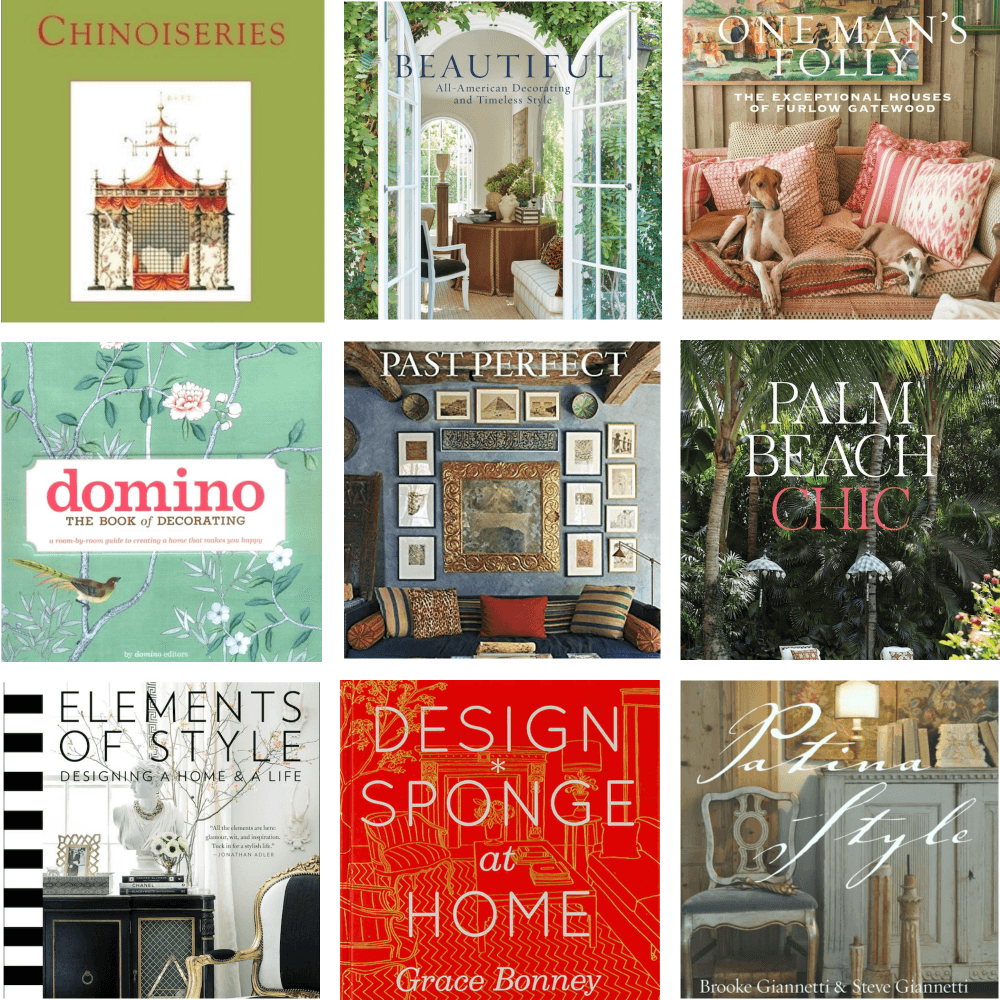

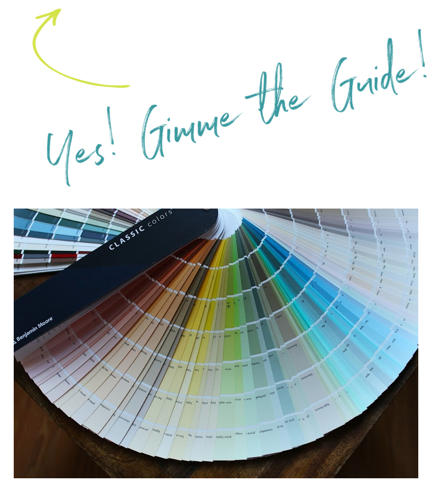
90 Responses
Armchair decorating is so much fun! Someone else has to do the work, my favorite. Personally I’d paint the living room ceiling a satin robin’s Egg blue and use white wax on the paneling, buffing it to a slight sheen. Then I’s throw down a fun reproduction Persian rug in the same blue colorway on the floor (with tan in it’s pattern). I’d strip that silvery wallpaper off of the dining room walls and paint them the same blue in a matte finish.
Sorry to beat a dead horse, but I just came across this photo on Ebay of well-done colonial-type knotty pine paneling. You can see how much finer the older paneling is, and how much more elegant the carving and milling.
NEW-YORK-INTERIOR-PHOTO-Library-Richard-Averill-Smith-Photographer
I am starting to side with those who are considering the option of reducing or removing the somewhat overwhelming paneling in the house featured in this post.
–Jim
That’s very lovely Jim. It’s difficult to tell from the photo, but it looks either white-washed or else bleached as the wood is so pale. But it might just be the photography.
Just came from a Show House where the builder purposely painted white over pine with knotholes and made no effort to disguise the roughness. Decorator detail! Rustic Charm! Go for paint if you want and no worries re: blemishes…Keeping it casual 🙂
A gorgeous home with very strange knotty pine use! Absolutely hire an excellent painter to paint that knotty pine (or remove it entirely if you have an enormous budget!). I’d also see if those fireplace columns could be removed or changed. In the dining room, I love the wallpaper, don’t remove it! But paint the woodwork a soft white. It will be so beautiful!
Hello Again,
I have been somewhat obsessed with this post and all the incredible comments provided by your loyal readers.
In my previous post, I also suggested painting the pine paneling and maybe the ones in the dining room. After reading all the problems with covering knots, I fear the work will be overwhelming and maybe not successful long term.
This morning, I had the outrageous idea that maybe the pine paneling should be removed, along with the oversized niches, the fireplace surround, the dentil molding, and the French doors. The walls could then be plastered or drywalled. The fireplace could be redesigned, and the French doors replaced by floor-to-ceiling, matching-style windows. A glass-paneled door, or something similar, could allow access. The same amount of light would enter but the overall look would not be so “70s!”
Then, I would refinish the parquet floors in a dark tone, maybe almost black. Again, I would think of the beautiful simplicity of the exterior, in black and white, and try to bring in more black and white, such as black and white tiles in the entrance.
I personally would remove the commercial wallpaper (not hand painted) and then paint the entire dining room. I feel the wallpaper would not be a good background for art and beautiful wall lighting, such as brass sconces.
Oh dear, I hope I have not suggested things which are too outrageous. I love the house but feel it needs to meet both a standard for good design as well as provide a welcoming environment for the family.
Kirsten
I can see changing the fireplace insert and surround, but please keep the rest. At least consult a good painter and he will probably be able to take care of the knots and so forth. Oil based or shellac primer should seal them, and filling in any holes shouldn’t be too difficult, and definately worth the trouble! One reason real Federal homes had painted woodwork was to conceal such flaws, and to make it look more like the buildings of Greece and Rome.
I think that would save what drew you to the home, and probably would cost less and create less dust and dirt anddisruption. Consider carefully because you won’t be able to go back.
Also, mis-tone wood floors are more classic, see all those old Parisian apartments with parquette floors, and show less dirt. Also, I think dark floors aren’t as popular as they once were. If you aren’t careful, you house will scream 2010 instead of 1970s, and it will date all over again.
@Kathy
Thanks for your considered reply to my post of this morning.
I agree about dust bunnies being more visible on a darker floor. And, if they use lovely rugs, most of the parquet look (re: several earlier comments about parquet floors) would be covered up!
I agree it would be quite messy to tear out all the paneling. Paint WILL be perfect, if the knotty problem is solved.
Kirsten
I love all of the architecture in both rooms. They would both look great painted white or even in clients favorite color. I did see a few ideas in Mark Sikes new book Beautiful that reminded me of their dining room. Thanks for sharing these beautiful rooms!
Connie, what a beautiful home! I would definitely paint your knotty pine! Doesn’t seem like the right wood for your beautiful paneling, so painting would hide that. Careful though, get a good painter! I once had a knotty pine bookcase wall painted white and the knots showed through, even after several coats. So a good primer for sure. Then maybe one of Laurel’s beautiful creamy whites from her rolodex.
Even though chinoiserie wallpaper is beautiful and woukd match the historic period, it looks like this one has a ‘mirrored’ silver background- maybe a nod to the 70s when it was built? Not my favorite.
I love Laurel’s post on grisaille wall murals- wouldn’t that be lovely in this dining room? I am about to move into a new home in California, wish I could do grisaille or wood paneling somewhere! But the textured wall/ great room Mcmansions we have here just aren’t suited to it. Grateful to have my new home anyway!
Enjoy your lovely classical new home.
Oooh ooh ooh! Before I got to the historical examples my impulse was to paint the living room FOR SURE (those knots are terrible blemishes for this style of paneling) in a medium-light greige or a putty/green-beige color. All one color. The historical photos just strengthened this conviction. The dining room I could make a case for leaving it stained if she didn’t want to paint every room, as long as there was a lot of soft blue and cream brought into the rug and furnishings to create some balance with wood vs color/paint. Good luck and what a gorgeous house!
I would paint that knotty pine woodwork in a heartbeat! I’d go BM Linen White, but that’s just me. Paint the back of the bookcase a color. Beautiful home! Please send us the “afters!”
Hi Connie! I have still been thinking about your predicament, because I have been there too, and (someone may have mentioned this) I think the reason that you can’t mive forward with the idea of what paint colors is you need something (art, fabrics, rug) to relate the color too.
For example in the dining room you have the wallpaper, but in the living room you only have the fireplace.
I think once you have chosen/have to use a painting, fabric, or rug, you can use that as a jumping off place to move forward with a color, then the room will come together and start to make sense.
Hopefully that helps! 🍀
Connie, What a lovely home! I’d be paralyzed too, facing a whole house update! The woods in the LR and DR not matching is interesting. The LR “whitewash” & paint residue in the dentil moulding suggests the LR room was originally painted. As does the current white on trim/doors. That stark white and the adjoining white space is making the wood even bossier so I’d look at toning down the white, aiming for less contrast. You mentioned that you do not want anything too formal. So, if you decide to paint, again, I believe a muted color would work better than white. (Of course, Laurel’s paint guide would be great resource in choosing a color!) Could you focus on other spaces for now and let those choices lead you to what’s right for the DR & LR? I’ve heard that its best to choose your furnishings first, paint last. If the parquet flooring bothers you, I think laying seagrass about a foot away the walls, would minimize the so.much.wood, brighten the space and take the formality down a notch. Personally, with today’s trends, I’d consider painting the DR (amazingly, my husband agrees!) and keep the pine LR. I think conditioning the LR pine could help its appearance; it looks dried out. Updating the fireplace wall and bookcases by painting/wallpapering the interiors could balance out the room. Can’t wait to hear Laurel’s ideas 🙂
I vote Wedgewood blue. (have the painter fill the knots)
Oh man, I love Wedgewood blue! I spent my elementary school years in a house with kitchen cabinets painted that shade, and then of course a big collection of wedgewood in the dining room.
Then after years living in colonial revival style houses, my mom got sick of it, sold all her furniture and bought a contemporary condo in the big city 😉
For a house built in what is probably the priciest neighborhood in Old Town, the builder cheaped out with that knotty pine panelling. It suggests that the original owners demanded wood for the room couldn’t or wouldn’t pay to upgrade the wood. It appears, however, that the workmenship was very good. Since it is neither very old or an accurate historical reproduction, painting it would be in keeping with what was done in other nearlby homes, especially Mt. Vernon.
Oh I wasn’t going to comment but then my mom said something to me last night when I asked for some advice and I thought it was brilliant. She said, “Genie, there is more than one right answer here”. Ha! so many times I have very extreme black and white thinking and I LOVE how my mom thinks…so very fluidly. Your house is UNBELIEVABLE, and I am so so jealous. I just bought an old Tudor house and I am trying to be grateful, but this is really the house of my dreams. Personally, I would paint if that is your heart’s desire.
Hopefully you get it all sorted out and Laurel can send us the after pics just like Lori’s fabulous white kitchen in her Greek revival home. I am really loving the green paint from Farrow and Ball that Laurel posted, but only you know what will work with your furnishings etc, the house has amazing bones, and I always feel that paint covers a multitude of sins….Oh Laurel, as usual you are so generous with your ideas!! I am really excited as I purchased all of your rolodex’s etc. I LOVE LOVE LOVE them!! I would recommend them to anyone. The widgets of different rooms with different colors might actually spark some creativity and ideas on what color to paint these rooms….just a suggestion…..I was leery of buying resources like this on line but I feel they have been worth every penny! I have always been very color shy, but the guide teaches you how to incorporate different colors in one room. Many blessings to you and your beautiful new home!!
As one commenter points out, this is a replica rather than an original, so no crime will be committed no matter what you decide.
I certainly think the knotty pine room should be painted, all one colour. Note that in Laurel’s first historical image the paint is all one colour, but it’s broken colour on the big panels, an important detail. It is essential here to use knotting compound to prevent bleed through: I promise that otherwise the resin will seep through and discolour 20 coats of paint in 30 years. Bright white is not the way to go: a “dirty” colour, such as F&B’s Shaded White, would be good. I recommend the blog “Modern Country” for its studies of F&B colours to get an idea of how such colours work. The fireplace needs a change too. Are the brass things doors? and if so, can they be removed to have a proper open fire? Ditto the granite, unsuitable to the “period” panelling, and the small tiled zone on the floor could be painted black to look like slate, which would be OK.
As for the chinoiserie paper room, either the wood tone panelling has to go (paint), or the paper. Depends on whether you like the paper or not. I don’t think it suits the room, but that’s just personal.
I don’t think you need worry about the modern parquet floors. Provided you use large enough area rugs, they won’t be noticed. At the moment we look at them because the rooms are empty, but when there’s furniture, art, mirrors, they’ll fade into the background. One commenter says such floors are found all over Paris: yes, but not in older homes, only in 1960s-70s places.
Another blog to look at for ideas is Greet Lefèvre’s Belgian pearls. Lots of panelled rooms there. And Laurel’s past posts, of course! Take your time and enjoy the process. I hope we get to see the finished version.
As one commenter points out, this is a replica rather than an original, so no crime will be committed no matter what you decide.
I certainly think the knotty pine room should be painted, all one colour, but note that in Laurel’s first historical image the paint is all one colour, but it’s broken colour on the big panels, an important detail. It is essential here to use knotting compound to prevent bleed through: I promise that otherwise the resin will seep through and discolour 20 coats of paint in 30 years. Bright white is not the w
I like your home very much. I think the living room needs paint, the knotty wood which I would normally find charming seems to be fighting the design of the room. There should be one star there and it should be the beautiful architecture.
I think….the fireplace is wrong? The brass seems jarring, I don’t know what I’d replace it with, a decorative screen?
I love the wallpaper. I don’t know if it is 100% the best wallpaper for that room but it is beautiful. I would not paint that, and I think I would take the blinds down and put window boxes, with maybe pink flowers.
I live not too far from Alexandria, just over the river in Maryland. I, too, love and appreciate the beauty of Georgian/Federal architecture and furniture. Anyway, I’ve heard, from various sources, including tour guides at many of the historic buildings around here I’ve toured, that during that era, the only woods considered good enough to be left exposed were mahogany and walnut!(If you had enough money to live in a home like that, of course.) Knotty -pine paneling left exposed is probably more of a “neo-colonial” interpretation, rather than a true Georgian/Federalist detail. So Connie should not feel guilty painting it if she wants to- the colonists would have!The detailing is quite lovely and the home will be so beautiful, I’m sure, once it is decorated.
As an alternative to solid paint, could the wood be whitewashed or lime-washed with a heavier coat, so more of the wood is covered and lightened, but a little bit of the texture is allowed to still come through? That way, you wouldn’t have to worry about covering all the knots up completely–it would just add to the character.
As far as paint colors go, one thing they tell you when you tour Mt. Vernon and are taken aback by some of the bright (gaudy) colors of the rooms, is that those colors were popular at the time because they were very expensive. It was a way to show off your wealth (though I have a hard time picturing George Washington being a show-off, LOL! He was a man of amazing character. Anyway, maybe he and Martha just had a hard time picking paint colors from a little paint swatch–just like many of us do today!)
Connie
You have a lovely house! You mentioned wanting to lighten the rooms up. I would pick a warm white from Laurels selection, maybe cotton balls or whatever works with your wallpaper, and then paint everything. A lot of the detail of the wood will shine through once painted that hides when stained, Plus it will really open up your rooms and make your floor look stunning. We had a brass fireplace screen and sanded it a little then painted it with stove black paint that withstands heat. It will change the look a lot.
Maybe go buy a section of wide trim from a lumber store then try out a few paint colors on that to see how the dimensions look to you.
Best of luck!
Embrace the knotty pine! See the Mark Sikes room Laurel linked to on this page. It is gorgeous! It is both warm, cozy, and light and airy because of the fabrics he chose (blues). I’d definitely be worried about knot bleed through eventually if you paint. Most of the floors will be covered by rugs, I assume, so leave the parquet if you want (although new wood floors would be beautiful).
There is plenty of good advice in the comments already so I won’t repeat. Just want to say I have lived in my Victorian 3 story home for 40 years. It had beautiful oak trim throughout the first floor with two sets of oak pocket doors. About three years ago, pretty as it was, I had had enough of using colors that worked with the yellowish oak and I painted everything OC-23 Classic Gray. What a difference! I have not regretted it once. I painted the window frames and sills BM French Beret and now have colors I was never able to use before. That much wood in a house and the wood becomes the boss. Maybe not all, but some of it has to go. I would start with the knotty pine.
Btw the chinoiserie wallpaper in the dining room would be stunning with the F&B Calke Gree shown here in Laurel’s post. If only architects were required to study classical residential architecture we wouldn’t have these issues. LOL. Ben Pentreath’s book Get Your House Right should be required reading!
Laurel-Some of my favorite Ralph Lauren style libraries were knotty pine-love it. However this is a dining room. I adore painted woodwork. I bought the fan deck of Farrow & Ball paints just to keep me focused as I decorate my English Country home. I’m sure the BM Historical colors could also guide. I would absolutely keep the parquet floors-they’re in many a French chateau. However after choosing the paint color I would at the same time choose a complimentary stain. Don’t wait until the cabinets are painted; make the color decisions in advance and create a design board. Why not get the family in on it? I suffer from the same malady; it’s an affliction that only strikes when it’s your own home that you’re designing!
I’ve read all the comments.
Paint the living room for sure. Look for a timeless white that is not stark.
Change out the marble and the strange red brick on the hearth of the fireplace.
I’m on the side of also painting the dining room even though it has better wood. Isn’t that fact strange in itself?
I would leave the dining room wallpaper if owners like and and paint it a soft color which plays off the wallpaper.
If the owners do not like the wallpaper, paint any color desired, but I would go with the same white as the living room.
Unlike many, I am not offended by parquet flooring. After other changes are finished, decide about refinishing the floors to better compliment what you have done.
After all Paris is filled with parquet I’ve been given to conclude. Please correct me if I am wrong on that.
Hi Laurel, Hope you’re having a good trip:). IMO Connie should have the wood painted and I think she is right not to assume it should all go white. The examples you showed of finished rooms really illustrate how gorgeous a great color will transform the room. It will take a good plan to coordinate all the rooms with fabrics etc. I’m not sure if anyone suggested this yet as I can’t read the other posts until I send this but…maybe Connie should work with a decorator (if the budget permits) to pull together the fabrics first and then the paint colors can be coordinated for a cohesive look. Then the idea painting the wood may just seem like the icing on the cake:)
Wishing Connie success on her project. Best Regards, Leslie
Yes, the house has great bones! I’m first inclined to save the wood in the Living Room, then seeing all of the lovely examples of paint that Laurel has posted, take that as your clue. Paint the wood trim and paneling accordingly. The fireplace does need some updating, and please, remove the marble from the top of the mantel. As far as the flooring goes, the outdated flooring drags down the room and is way too dark. I’d replace that flooring with a lovely wood.
The Dining Room. Again I would be inclined to keep the wood, possibly because it looks like a cherry, and very expensive to begin with, so think about keeping that wood tone. The wallpaper is lovely and appropriate to the period, but I think maybe something lighter would help to brighten the room. The parquet flooring needs to go because, well, its just outdated. Good luck and have fun!
I agree with the paint all that wood idea.
BUT – painting pine can be frustrating in the extreme, because those knots, no matter how much you shellac them, Zinsser them, etc, will never stop bleeding through.
So – more radical/costly suggestion would be to cover it all up with drywall, or at least the more offensive parts.
In reality, I’d probably feel swamped at the very thought and leave it as is.
Lovely house, what a boon to have a new house in a historical part of town, so you’ve got mod-cons like modern plumbing, wiring, etc.
I have been thinking about your comment off and on all day. I’d no idea that knotty pine would bleed through. Our home has a thin layer of plaster over drywall which sucks for hanging pictures but is pretty to look at. Perhaps that is an option? Maybe faux bios would be a solution and the look could be tempered, like when you cover a tattoo.
If the knotty pine walls were original and had historical value, I would be more hesitant, but they really don’t work with this house. Paint them with a Benjamin Moore Historical Color – Linen White is what we use in our 1848 Greek Revival – a soft white that looks beautiful at all times of day and emphasizes the architectural detail. If you want a darker color that would work too, but it’s easier to change your color scheme in the rest of the room in future years using the Linen White. Also, take that TV down and replace it with artwork!!! TVs on the wall are all the rehab rage but look stupid in a house replicating this period. This room is gracious – treat it accordingly…it can still be casual with a mix of antiques and comfy furniture. Good luck!
I would paint it all. Historical colors are rich and bright and -not- grayed down (even Williamsburg has gone bright because their research indicates colors were much brighter in the colonial era). That said, this is a little later, and bright pastels were the norm then. I would love to see a pure, grassy green, enamel blue, pumpkin or buttery yellow on all the paneling, including the trim. Imo, nothing needs to be ripped out, as if it were painted the dentil molding would not look busy … now, it is a formal look fighting lodge-y knotty pine. This is a gorgeous home (so envious!), but it is a home, not a historical restoration. So I would go more with respecting its bones and not pick anything I hated just for the sake of history. But … and it’s a big but …I would try very, very hard to avoid today’s trends, or risk looking to future generations as wrong as knotty pine paneling in this gracious home looks to us now.
I agree with one of the first commenters who suggest to go with a putty colored paint. It’s a nice historic-type neutral. Or just look at the Benjamin Moore historic colors and pick something you like from the lighter tones. Good luck!
P.S. We ended up repainting in a few years with a soft cream with white trim, but there were no adjacent rooms with a lot of panelling so no need to have it all white to be consistent.
Well, this is a situation where you should follow Laurel’s advice and test, test, test if you decide to paint your paneling. I painted our living room paneling white, without really testing first, and it was not a good white for the room or my artwork. I have seen some lovely panelled rooms painted a soft delft blue or cream and they were beautiful, but that may be a color commitment you may not want to make.
An alternative would be to really lighten the wood–almost bleach it. Of course all the knots would still be there!
As a native Virginian (Richmond) and lover of Colonial Williamsburg, I have been exposed to this style of architecture my entire life. Williamsburg has spent so much time studying the period and even correcting their own errors as more information becomes available.
The Governor’s Palace at Colonial Williamsburg is an excellent example. The Great Hall has always been stained but guess what – they discovered it was wrong for the period and just painted it. Their research revealed that during the period, rooms that displayed arms were painted so the displays had contrast. I doubt you have arms to display but you probably have art and that would seem to be the same issue.
So here is your permission…even Colonial Williamsburg says it’s ok!
Here’s a link to an article regarding the Governor’s Palace:
http://www.vagazette.com/news/va-vg-cw-gov-palace-0110-story.html
Highly recommend the book, The Chesapeake House, Architectural Investigation by Colonial Williamsburg by Carson and Lounsbury, which covers Tidewater Virginia and Maryland architecture.
I particularly like this comment from the knowledgeable reader. This is great advise if Connie wants to keep the house historically correct.
Thanks for sharing this. This was really interesting.
Connie has a very beautiful home! I would paint the knotty pine woodwork in the Living Room. I would recommend a soft light putty colour like Benjamin Moore Abingdon Putty HC-99. (I would find white or blue on the woodwork too cold looking in this room.) It would be best if you could change the fireplace surround. It looks like there is also marble on the mantel shelf, which I would remove. Laurel has several posts that include ideas for hiding the TV, maybe you could use one of those strategies for hiding the TV over the fireplace, or maybe it’s possible to move the TV to another spot in the room (where it could be placed at a better viewing height), and place art over the fireplace.
If you go with a putty colour, I envision ivory, light & dark putty/green, with a little caramel as colours for furniture & rug, with a range of textures mixed in.
I would not paint the woodwork in the Dining Room. It is better quality & a nice feature worth retaining (given the historic style of the house & exterior). I would remove the wallpaper though, and paint the walls. I find that the wallpaper pattern is fighting with the details of the wood, and their colours do not compliment each other. Removing the wallpaper will let the details of the woodwork stand out. If the Dining Room is visible from the Living Room, then you could paint the walls in the same putty colour.
I guess I’m the lone ranger here but I would leave the wood. The first thing I would do would be sand the floors, stain them a deeper richer color in a less shiny finish. I can’t tell if the ceilings are blue or white but a deeper color there would help also. We have a paneled room and I think we used BM Dinner Party and it is the coziest room in the house. I would also paint the window and door mullions a dark color- probably a dark brown or green that reads almost black, something that works with both the fireplace stone surround and the wood. Nothing enhanced my house more than painting the window mullions dark- it really brings the gardens into the room where white used to stop the eye at the window. I would also replace that brick thing in front of the fireplace with something more solid that works with the existing stone and remove the piece of stone that is on the mantle. You could paint all the fireplace surround, all the area between the fluted columns and maybe inside the flanking bookcases to break up the wood if you like. Not sure I’d do that though. As the wood is an earthy color scheme I would paint the white hallway a more earthy color- bright white and wood aren’t “cousins”. And lastly, alas, I would remove the wallpaper. It doesn’t look hand-painted to my eye but if it is- and you like it- maybe you can have it gently removed and placed in a powder room somewhere. Most of these things you could try before committing to the expense and permanence of painted wood. As you like a light color palette I suggest talking to a color consultant for some ideas. Your home could be really rich- and casual. Good luck and have fun! with it!
I love the woodwork but It would be gorgeous painted! I would paint all of the woodwork Benjamin Moore’s “Bennington Gray” and walls, “White Dove.”
I’m extremely particular and my husband and I are using these two colors entirely in our newly purchased Reproduction Saltbox.
It’s a soothing yet very cozy feel. The “Bennington Gray” changes with the light during the day…always beautiful. I would swap out the brass fireplace screen for black and paint the glass door frames “wrought iron.” Decorate the walls with framed antique reproduction prints of owls and birds or botanicals. Also, since it is a family room, a colorful rug such as HG625A by Safaveigh would be very attractive as well as practical.
What a beautiful home you and your family have found!
I would definitely paint everything. The DR paneling is “better” than the ugly pine in the LR, but is not really great! The comments above point the way to a much more friendly home.
I agree about trying to get rid of that dentil molding. The problem is, as I see it, there is too MUCH detail. The shadows within the dentil molding make it look too “busy.” However, if they cannot be removed, paint will make them look less obtrusive.
In addition to paint, I would work very hard to change up the fireplace wall. The comment about removing the vertical columns next to the fireplace was spot on. The exterior of the home does not dictate that “Grecian” look. The niches are rather large, but not changeable, I am sure. Then, focus on the fireplace itself, bringing it out of the 1970s and into the period. There are hundreds of ways to go with the design. The skimpy, new-looking brick in front needs to be changed and certainly enlarged. The bright brass is too 1970’s. (And, no TV of course! LOL)
What a magnificent home. I think the exterior look must dictate the colors, the tone of the whites, and the style of the detailing.
Kirsten
Oops, I should not have used the word “above” re. comments. Sorry.
Hi Connie! What a beautiful house. I also say Paint, Paint, Paint all of it.
And as people have commented go with your gut. Take the risk, go all the way, I have done that with color In our house and it is amazing!
Dining room – I would definitely do a color that brings out the wallpaper. It looks like a blue or green, or maybe a green/blue..and when I say color I mean something not at the top of the color strip. Something richer…
Living room – I might look at a neutral with a green undertone (to coordinate with the fireplace) or again a color.
Of course I love the idea of using historical colors like Laurel suggested.
Good luck!🍀
this problem does not have to be an all-or-nothing matter.
first, ditch those dreadful parquet floors. combined with the divided light panels of the french doors, they create an eye-crossing jigsaw puzzle effect which would be even worse if they were lightened. so, out they go. plus, they really scream 1970s!
next,change both the fireplace granite and brick to something light such as callacatta gold marble.
add light and airy furnishings with some very dark accent pieces to create a visually pleasing interplay of multiple shade depths. this would allow the paneling to recede into a middle-shade background instead of overpowering the room.
if she still feels the rooms are too dark, consider painting only some of the wood e.g. the interiors of the wall recesses, the fireplace surround, etc.
my point is, dont do anything radically tranformative that might be considered a mistake in a few years, and would cost a fortune to un-do.
Beautiful home and not to offend; I would definitely consider painting out the ‘knotty’ pine in the living room area as IMHO it is unfortunate they used it in the first place. IF not sure of the process; ask the advice of ‘a finish carpenter or someone experienced in woodworking’ for their expertise and ensure to mention that its been lime-washed. Secondly prior to doing so; I would be tempted to rework the design of the fireplace itself as well since feel the leg plinths are too massive. Also if keeping the current facing; replace the existing screen with something not as ornate and possibly change out the current brick hearth. As for the parquet flooring and presuming it is not a veneer or laminate; I actually love it with its mix of woods that always can be stripped (if waxed) or re-sanded (if varnished) and optionally stained and re-sealed to your liking. As for dressing it with area carpets (and not being an interior decorator myself) I feel much will depend upon your furnishings and life style. To conclude; wishing you success in your upgrading journey.
-Brenda-
DON’T paint the living room. It is stunning. Decide if you are going to keep the wall paper or change it and then decide on the colors for the rest of the house. I’m not a huge fan of wall paper as my mother redecorated our ranch home in 1976 so we had 1st generation metal blinds and wall paper depicting 1776 soldiers marching with a flag and drums. Having said that, the wallpaper in your new home is lovely. If you keep it, find soft colors for the rest of the house that work with your beautiful dining room.
Sorry, meant to say don’t paint the dining room. Definitely paint the living room:)
You know how there is now a design trend for rustic wood – there was also a trend for it in the 70’s but it looked a little different than now. That’s why that wood is like that in your house and why it has all the knots.
I would spackle & cover up the knots as much as possible & paint it all white. I use to live in Alexandria & most of the paneling I saw was white & it was beautiful! It also had a lot of coats of paint from over the years, so you can put on as many coats as you want to cover the knots.
Paint, paint, paint!!! So funny, but Mt.Vernon is what came to mind immediately. My sense is that the style of the trim (is that dentil, Laurel?) is never seen in natural wood. I wonder if the previous owners intention was to paint the wood and they were talked out of it. It is toooooo much (ugly) brown. I’d do white with pale blue baking the shelves in the first pic. Maybe a pale color from the wallpaper (keep it!) in the dining room. I grew up with a “don’t paint wood” mantra and it took me a long time to leave that baggage behind. Let us know what you do, Connie!
We recently painted our knotty pine paneled den and it looks AMAZING! The dark knots have NOT bled through. We first did a light spackling skim coat on the dark spots, followed by two coats of Zinsser Bulls Eye primer ( worked amazingly well) over all the walls. Some additional priming over dark spots was necessary and two or three coats of Benjamin Moore paint. Patience, sanding and attention to detail are key. Young House Love has a great older post on painting paneling that was really helpful.
Laurel- I can’t tell you enough how much I enjoy your blogs and what a resource you have become to me!
@Beth: I am a big fan of Zinssers Bullseye 1-2-3 Primer as well …. ☺ …. as even have had success with it for exterior use on pine fencing and never have had knots (or rust stains from ungalvanized nails/screws) show through. Also, application of shellac over knots (on any wood — live trees as well) is helpful too, as a bleeding preventative. -Brenda-
Hi Laurel,
Before we converted the Victorian school we had another house just down the street. It was a grade 2 listed Georgian town house built in 1720 ish. It had a paneled drawing room that had been stripped back to its pecan pine roots. I desperately wanted to paint as the room was dark but my husband said, no… we had also inherited a bright red axminster carpet ( also destined to stay). This was one of those old houses where you could be afraid of what you would find if you looked too hard under carpets or floors!
Anyway, we sold it to a young couple, who promptly painted the paneling and ditched the carpet! From my not so discrete peeps through the windows it looks fab! So my vote is paint the paneling.
Also just to add according to the Listed buildings magazine, paneling was meant to painted unlesss it was Mahogany,
Paint and more paint. Laurel’s post cinched it. Loved the yellow dinning room and white rooms! So fresh and cheery. Seeing the historically correct pictures encourages one to go so much fresher. Great post Laurel.
I totally agree, I don’t think you have any choice but to paint. Do you keep a baby grand piano that you hate and no one plays because it was your grandmothers? Heck no, let it go and live YOUR life. A creamy warm white would be amazing and bring in color through the furnishings, rugs and art. Don’t sit in that dark room because it’s historic, and always been that way… enjoy your home! there ARE no rules! Go for it.
The woodwork is so beautiful. I would paint it a soft white or cream. A dark color would just take away from some of the detail.
Margaret at 8:33am is correct that the knots will bleed through over time even if properly sealed and this is why you need an excellent painter with great product knowledge. This woodwork will sing if painted and I would not hesitate a second. Pine is not a high end wood so you are not covering a wonderful grain. I love White Dove by Benjamin Moore. It is not a bright white so won’t blind you. Simply White by Benjamin Moore is another winner. You won’t go wrong with either one. I’m not a fan of dental molding. If you could hire a carpenter to remove that and replace it with something simple and smooth you may get less of a formal feel which is what you are going for. The fluting on either side of the fireplace calls too much attention for me as well. I would replace that with smooth wood. I think your house is lovely….I vote for painting the wood….all of it. : )
Oh Connie, I feel your pain! We just moved from a beautiful colonial house that had pine paneling, beams, etc It was not pickled or lightened. I kept telling myslef it looked like a “gentleman’s club”…which it did. For 36 years I went back and forth about painting or not painting. I never had the courage to do it. Here is what I learned. If you keep the paneling as is, “heavier colors” work well…darker blues, reds, greens and gold. Even in art, oil paintings woeked… watercolors were not substantial enough on the heavy walls. If you paint…do it and don’t look back! If it were me, I would paint the dining room and leave the living room. But here is what NOT to do…do not live in limbo for 36 years!! Ha! Go with your heart! You probably know the answer to what you really want, you are just afraid you will regret it. When actually, what you will regret is not following your own instincts. Good luck, it is a gorgoeus house!
I would paint it ALL!! The wood paneling in the DR is much nicer but I don’t think it looks good with the floor (and the wallpaper if you want to keep it). I would paint it a color because I think the white will make the room look more formal. Not too dark of a color –maybe like the blue or green above. I would decide on a general color (Blue) and them look for a great rug to start with and pull your color from there. I always think finding a rug you love after the other decorating is done is much harder. If you want to keep the dining room in wood I would get a large rug to cover most of the floor….but definitely paint the LR!! Good luck–you have a fantastic home!!
Knotty pine is a tough one. It can look good, on rare occasions, of which this is not one. The room should be painted green or blue, with the interior of the arched display cabinets a coral colour, as done in the 18th century. And I have an identical shiny brass firescreen, which should NEVER be made black. Why ruin a perfectly good firescreen, and black is a trend, not a style. A trend which has come and gone. I’m not a fan of that type of marble in a surround, but that’s an expensive fix. With a painted wall around it, it might improve. Having a television set there looks ghastly, however. And the wildly expensive and gorgeous chinoiserie paper would be a crime to remove. How could one possibly improve upon it? It’s all the rage now, anyway.
I guess it goes without saying the floors need to go. I would go with a shade of blue or shade of green on the walls, a grayed-down blue or green to make it look more “historic.” Seems like anything goes with blue or green so you could accent it with any colors in the furniture or accessories. I don’t know if I’m
a fan of painting EVERYTHING, like moldings, mantels, etc.
Leave the dining room alone. Paint the living room.
I agree with you, Jennifer. I might even consider a creamy white paint on the living room paneling!
First your home is beautiful! I really liked the wood in the dinning room, but if you can paint the pickled knotty pine, I would paint it.
i agree with most of your readers that the rooms would look so much nicer painted but where I disagree is on the colour. I would not select white. I also love that period and you have posted some great examples Laurel and they are predominantly colour. Beautiful, soft historic colours. Since Connie expressed a desire for a more casual feel and keeping it bright, a softer blue or green would be lovely. Even going into a creamy white tone would be nice. The wood work used inferior knotty pine so its not like you are preserving a beautiful wood. As a profesional painter, I would heartily recommend you hire the best painter you can find – there should be good ones in your area with all those similar style homes. With the pine, it is essential that the knots get shellaced – or they will bleed through the finish in no time. I would apply shellac or bin primer at least twice to prevent bleed through. It will still do it, but it should last many years before it does and by then you will probably need a new paint job anyway.
Paint both rooms! All that red wood is overwhelming, especially as you have the parquet floors as well. And it clashes badly with the white french doors in the LR. Hire an expert decorator to do the job and take care of all those knots. And consider hiring a colour consultant to advise on paint colours. I think light is the way to go, but not too bright a white or it’ll fight with the parquet.
Usually I would be indecisive about natural wood, however, not this time.
Paint the sucker. It will be lovely. Have fun!
I lived in a Georgian circa 1785 for over 20 years, because of the age we were careful where to make changes which included the wallpaper dated to the 1800’s in the 30 foot hallway. Two of the four bedrooms had extensive wood panels along with the two front rooms. Each of these rooms had painted woodwork in colors other than white. The other rooms had been ‘Victoranized’ with panels removed and woodwork painted white. English Cream is a wonderful color for a period home. Love the idea of keeping the wood look in the family living area a’la Mark Sikes.
White would be absolutely gorgeous! You could warm up the space with your furnishings and fabrics if white seems too chilly.
What an amazing home! I love it that the family loves the space and it will be used on a regular basis. I would go for the paint – personally I am a fan of white.
If this were truly historic home, I’d be tempted to preserve some of the wood, not all of it, but some. I mean, if wood manages to stay original for that long, it deserves to maintain that look. However, since this home was actually built in the 1970s, I would say brighten it all up with paint. Especially the room with the white French doors, because they look completely out of place in the midst of all that wood. And call me crazy, but I kind of dig that wallpaper in the one room.
Hello Laurel, I vote paint, and my personal preference would be for something in the white family. That wood does not look too high quality with all those knots, and the quantity is somewhat overwhelming. But on the other hand you did not show us photos of antique, original knotty-pine paneling. And I agree with Sandra–get the best painter possible!
–Jim
P.S. Great nod to the lamentably defunct “Reggie Darling” blog/persona and the talented designer Bruce Shostak!
Paint all wood WHITE!! What a lovely home to work with. Great bones.
From all the examples given the white painted wood is the prettiest and “feels” so much more updated. And picking colors will be so much easier. You can use colors that you truly love and never regret choosing.
i would probably hesitate to paint the dining room paneling, simply because it is much nicer looking wood. That isn’t to say I wouldn’t paint it, but I would definitely give it a lot more thought before proceeding. The pickled knotty pine, I’d already be filling knots and getting out the stain-blocking primer. I am a DIYer all the way, but that’s honestly a job I would hire out if I could at all afford to do it. All those knots are going to be a challenge to fill, smooth and prime so they don’t bleed through the paint. But it will be worth it.
I would not paint the LR walls simply because I am concerned that it will be very difficult to get a nice long term result with all those knots. The knots will need to be filled in with wood putty to get a smooth result and a few years down the road, they may show through the paint due to expansion/contraction during heating/air conditioning cycles. Instead, I would white wash the pine much lighter then it is currently. letting the wood grain show through. I would change those brass fireplace doors for black ones. I would cover those dated mid 70’s parquet floors with a neutral beige toned oriental carpet and use off white slip covered upholstered furnishings, I’d use blue patterned throw pillows. I’d re-do the display cabinets on either side of the fireplace with eye-catching blue and white porcelains. Finally, I’d use a low Chinese opium type table as my coffee table.
I would paint the DR paneling: either a soft creamy white or a soft sage green. I’d choose an ivory background oriental rug with rose and green in it and accent the room with famille rose porcelains. I’d replace the blinds with ivory drapes with tapestry or machine embroidered tape. Finally, I’d look for an older statement chandelier at auction because there are some nice auction houses in the DC area.
Definitely paint it – the workmanship looks awesome but the quality of the wood is not. Agree with Alison – it’s a replica and that liberates you from any responsibility you might have had to preserve a genuine antique! Then share the photos please!!
I am in agreement with most of the ladies here — Paint the woodwork and paint it WHITE. You won’t regret it and painting the wood white is clean, modern, yet classic. Beautiful mansions in Beverly Hills have painted white woodwork throughout and it’s gorgeous!
Looking at the above photos of “painted” woodwork, note how the very last photo image of the white woodwork is bright and open. The green woodwork is a gorgeous shade, but so dark, in my opinion. I love light and sunshine. With white woodwork you can have any color or style of furniture. A lot more flexibility. With other colors, you won’t have that flexibility. I am not an expert, Laurel is the designer, and I think her work is exceptional from what I have seen online.
Best of luck in your new home (with the beautiful white woodwork, ha ha!).
Connie, thank you for inviting us into your lovely home. It’s a big decision – to paint or not. I think the living room is heavy though and would benefit from paint. One issue I see is that the colour and style of the parquet floors clashes with the pickled walls. By painting the paneling, you can let the floors shine. I would also consider removing the columns flanking the fireplace. You could do lovely marble tile on the fireplace surround and hearth and either remove or replace the gold doors – or spray paint them black. That would lighten things considerably and feature the painted built-ins.
I love that Laurel demonstrated a mix of painted and stained woods. The dining room wainscoting is gorgeous – leave it – but, again, the floors compete. I would get a large, light carpet in there and use painted furnishings and maybe slip-covered chairs. I like wood furnishings in a painted room and vice versa. May I suggest an exercise I’ve used? Get some magazine pictures that make you swoon. No more than 5. Hang them on the LR walls for a few days and then take one down each day until you are left with your favourite. Then trust your gut and take the plunge. Oh – and remember to have fun! :). Looking forward to seeing the final results.
Pickled knotty pine has an appearance that suggests a cabin get-away. The era of your home design, being based on classical influence, is sophisticated. So the two are a visual mismatch. Paint would be perfect and you will love the end result. When I say sophisticated, that doesn’t mean too formal or stuffy. As the beautiful photos show, paint is historically sound. If I were you I would hire a pro to help select colors. Maybe the wallpaper is pretty, but is it correct for the house and the colors you will choose? Don’t let the wallpaper predetermine your palette.
What a lovely house! I would also vote to paint. We haven’t seen the other rooms but the living and dining would appear to benefit from a light color on walls and woodwork.
I can’t wait to see what you recommend and what she decides for the floors.
Paint it, please! My eyes literally ached from looking at all this stained paneling. I can’t imagine living there without getting a headache everyday. :). It will be lovely. I think I’d go with some shade of white. The place will glow. Lovely possibilities in this home. Lucky you.
paint. hire a superb, experienced painter. bring in the new!
perhaps a local professional consult on palette.
lovely problem to solve….
Paint for sure. Soft white in the family living area, perhaps soft green in the dining or pick out one of the colours in the chinoiserie wallpaper (I adore chinoiserie papers).
Or even a deeper, richer version of what you paint the dining room, in the living, so a tonal effect going from one to the other? If using colour.
What a gorgeous home, I am totally jealous, in the good way! 😊
Paint it! 100% !
Don’t paint the dining room, it’s better quality. Paint the atrocious 70 s wood in the rest.
Paint it! Choose a colour that rings your bell. For me it would be a soft white. The house in not listed or historical, it is a replica so no rules apply. I envy your dilemma Connie. All the best and enjoy.
I detest all those nasty knots! Paint! Paint! Paint! Make them disappear! Ugh. Dreadful. Sorry. But honestly just awful. Wish this was all I had to do to create such a lovely home. All the best!
I say paint and make it your own. Using colors you love but also go with the period. I love white woodwork but that is personal. I think the details will show even more without the knots in the pine. I find them distracting.
Beautiful home!